Contributory members are able to log private notes and comments about each site
Sites Anne T has logged. View this log as a table or view the most recent logs from everyone
Percy's Cross (Beanley)
Trip No.100 Entry No.4 Date Added: 26th Sep 2018
Site Type: Ancient Cross
Country: England (Northumberland)
Visited: Yes on 23rd Sep 2018. My rating: Condition 3 Ambience 3 Access 4
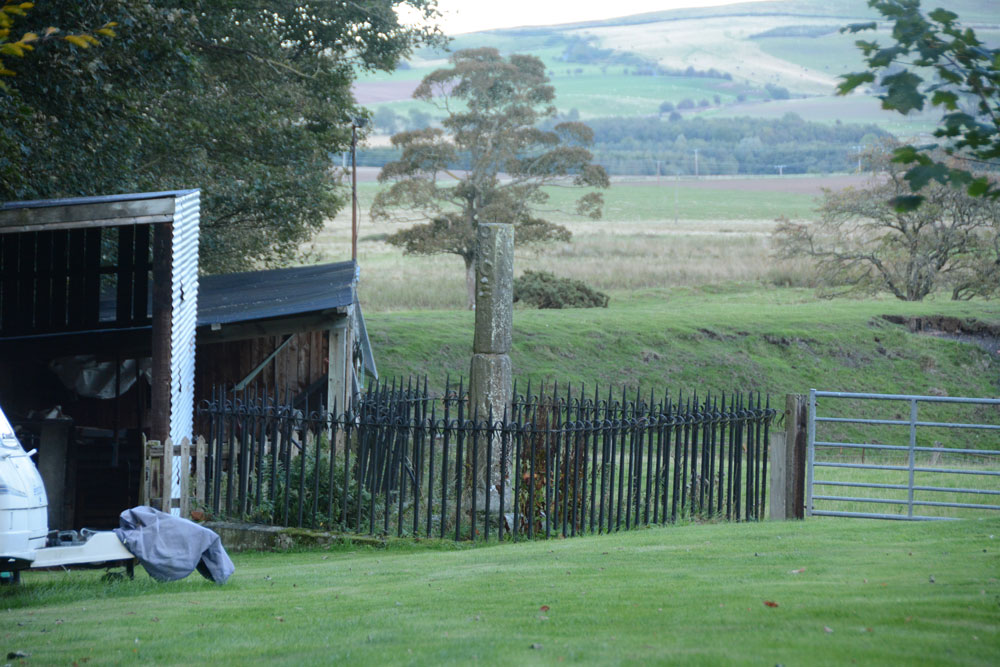
Percy's Cross (Beanley) submitted by Anne T on 26th Sep 2018. View of Percy's Cross, looking eastwards towards the now disused railway line. I'm standing in the middle of the field being used for caravan storage looking over the cross with its 19th century railings.
(View photo, vote or add a comment)
Log Text: Percy's Cross, near Beanley, Northumberland: We didn’t have enough time to head up the hill behind Old Bewick, as it had gone 5pm, and there was about a mile each way to walk to the first site. Having spotted Percy’s Leap and Percy’s Cross on the OS map, we decided to stop off and look at these instead.
It was difficult to park just off the busy A697, but we found the wide entrance to a farm track opposite the sawmill, on the western side of the road, and walked back to the farmhouse on the opposite side of the road.
We could see the cross from the gate into their garden, but the gate had a huge chain and even larger padlock. Fortunately, we spotted a track into the wood a metre or so to the north of the edge of the garden. Following this for about 100m led us to a gateway into a field being used partly for caravan storage, and this gate gave access to the very overgrown cross which was surrounded by iron railings with very sharp ornamental spikes.
Worth stopping off to see, although I wondered if this, being dated at 15th century, was too late to post on the Portal, although it is classed as a wayside cross, so I've posted it, along with its associated 'Percy's Leap' erratic rock site.
St Bartholomew's Church (Newbiggin by the Sea)
Trip No.97 Entry No.2 Date Added: 30th Sep 2018
Site Type: Ancient Cross
Country: England (Northumberland)
Visited: Yes

St Bartholomew's Church (Newbiggin by the Sea) submitted by Anne T on 26th Sep 2018. This unusual fragment is built into the southern end of the east wall, near the altar (inside). It has been interpreted as "a net with entangled fishes" (the fishes head can just be seen towards the top of the stone). This fragment is dated to the 12th century and is said to have been part of a column capital.
(View photo, vote or add a comment)
Log Text: Ancient cross slabs, Newbiggin by the Sea: The website for St. Bartholomew’s announces that the church “has one of the most important collections of coffin lids and grave markers in the county, mostly re-set during the 1913 restoration, when the north aisle, demolished in antiquity, was reinstated. Other fragments are distributed around the church and in the South porch. There are around 20 pieces in all. Most of the slabs are of late twelfth or thirteenth century date; several show signs of post medieval re-use.”
I have included my photographs and notes here, as I think these grave markers are more spectacular than those in Kilmartin churchyard – their designs are less worn and Peter Ryder, archaeologist for the church, has written about them in his assessment of the church, dated January 2013.
On the day of our visit, the mid afternoon sun was streaming through the windows on the northern side of the church, which made photographing some of the fragments a little tricky (my photographic skills weren’t quite up to it!) and the stream of visitors into the church made me feel rude by continually using the flash.
Some of the cross slabs are in the vestry and some in the tower, but it was not possible to see these. Another three have been used as paving slabs on the external west wall of the tower, but I didn’t spot these, as they seem to be worn.
From the small guide book “The Church of St. Bartholomew”, centre right page:
The two (cross slabs) above the altar at the east end are outstanding with their richly carved borders, delicate florets and symbolic shears and keys. An engraving of one was published as long ago as 1854, shortly after their discovery, when they were recognised as being of national importance.
Percy's Leap (Beanley)
Trip No.100 Entry No.5 Date Added: 26th Sep 2018
Site Type: Natural Stone / Erratic / Other Natural Feature
Country: England (Northumberland)
Visited: Yes on 23rd Sep 2018. My rating: Condition 2 Ambience 2 Access 5
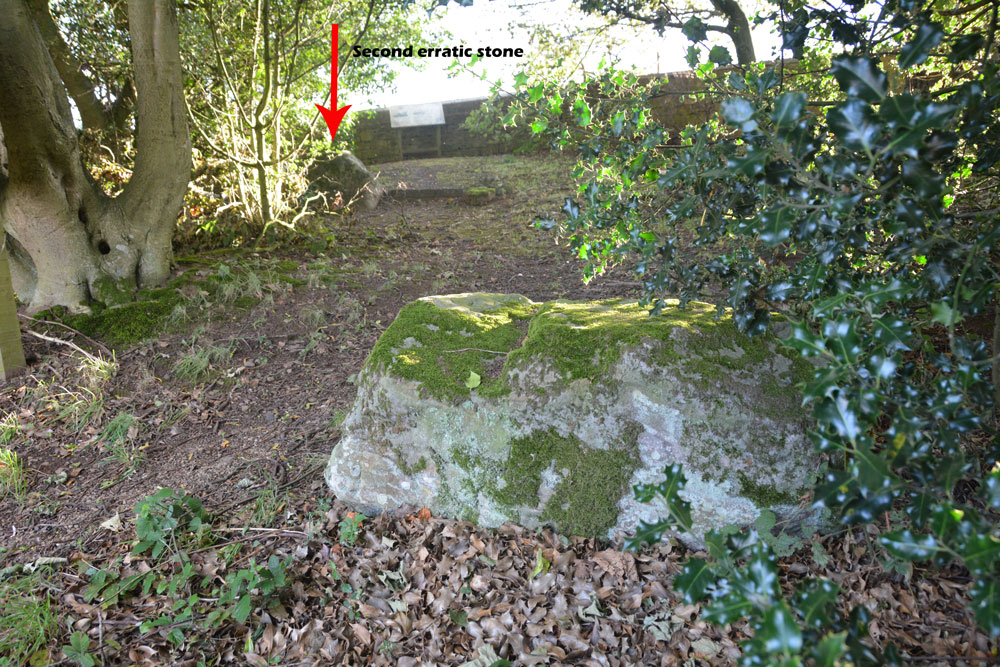
Percy's Leap (Beanley) submitted by Anne T on 26th Sep 2018. Standing near the gate to the enclosure, looking westwards to both the erratic stones. They are 9.5 of my paces - around 9 metres apart.
(View photo, vote or add a comment)
Log Text: Percy's Leap, Beanley (associated with Percy's Cross): Labelled ‘Percy’s Leap’ on the OS with a semi-circular enclosure marked against the edge of the road. Having the car pointed in this direction, and curious to see this site, as it sounded related to Percy’s Cross (by the name), we headed up and parked in the small layby by the information/interpretation board.
There is a low stone wall next to the layby and a gate leading into a semi-circular walled enclosure which is heavily littered and not pleasant. Inside the enclosure a two large stones, which look as if they have been dumped there for effect. In fact, these are two glacial erratics. There are two other interpretation boards inside the enclosure.
The first interpretation board inside the enclosure reads: “The Red Rose of Lancaster. For 30 years between 1455 and 1485 the two families of Lancaster and York fought for the Crown of England. Between 1461 and 1464 the North of England was the centre of activity in the Wars of the Roses. Edward IV supported by the Yorkists was on the throne which he had taken away from the weak Henry VI After the Lancastrian defeat in 1461 at Towton in Yorkshire Henry VI and his wife, Queen Margaret of Anjou, fled to Scotland to plan another campaign against Edward. / Sir Ralph Percy third son of the second Earl of Northumberland, changed sides four times in the Wars of the Roses. In Spring 1463 he was in the Lancastrian fold as were his castles at Bamburgh and Dunstanburgh. In 1464 Edward IV decided to seek a truce with Scotland to enable him to take action to crush the Lancastrians to the north. Lord Montague, younger brother of Warwick the Kingmaker, was sent to escort a Scottish mission through Northumberland in safety. / Learning of Lord Montague’s attempts to meet the Scottish mission the Lancastrians tried to ambush the Yorkists in Durham but this failed when Montague was alerted to the threat. Before proceeding further north Montague increased his forces at Newcastle. His path to Scotland was barred here at Hedgeley Moor by the Lancastrian troops of Sir Ralph Percy and the Lords Hungerford and Ros. / At the start of the battle Lords Hungerford and Ros decided to leave the field with their troops. Montague’s and Percy’s troops attacked head on. Sir Ralph Percy is reputed to have charged the Yorkist line at which his horse is said to have leapt and was wounded doing so. Sir Ralph fell soon afterwards and said at his death, “I have saved the bird in my bosom”. It is not known whether his final words meant that he died for his rightful monarch, Henry VI, or whether he had kept the secret of where Henry and Margaret were hiding. / Montague’s troops finished off the remaining Lancastrians quickly. Less than a month later the two armies met at Hexham where the Yorkists won a convincing victory which ended the Wars in the north for the time being. / Legend has it that the two stones in front of you mark the leap of Sir Ralph’s horse at the height of the battle.”
There is no record on HE for this site.
St Mary The Virgin (Ponteland)
Trip No.102 Entry No.1 Date Added: 10th Oct 2018
Site Type: Ancient Cross
Country: England (Northumberland)
Visited: Yes on 9th Oct 2018. My rating: Condition 3 Ambience 4 Access 5

St Mary The Virgin (Ponteland) submitted by Anne T on 10th Oct 2018. The round headed, tenth century grave marker, to be found built into the south wall of the tower. Having moved the boxes off top of the cupboard, to get the best view, I had to sit half way up the wooden staircase to the top of the tower, and point the camera through the slats toward the stone. We also needed a torch as well as a flash to illuminate the stone to bring out the shadows to see the shape of the cross.
(View photo, vote or add a comment)
Log Text: 10th century grave marker, Ponteland: As this stone was one of only a few listed on the Corpus in Northumberland that we had still to see, we had previously visited on 20th September 2018, but were unable to get into the tower. Today, I’d arranged to meet church warden David Butler, plus another David, who had arranged to open the tower for us. They were building benches for memorials, so I had to step over the boxes.
The grave marker was largely hidden behind boxes on top of the cupboards, so we moved the crates, then I climbed half way up the wood steps to get a photo. Great fun!
We got into a conversations about wells, as we were heading off to Bamburgh. David told us that there used to be wells in Ponteland (he lives in a street called Ladywell), there are none remaining.
Bamburgh Castle
Trip No.102 Entry No.4 Date Added: 10th Oct 2018
Site Type: Sculptured Stone
Country: England (Northumberland)
Visited: Yes on 9th Oct 2018. My rating: Condition 3 Ambience 4 Access 3
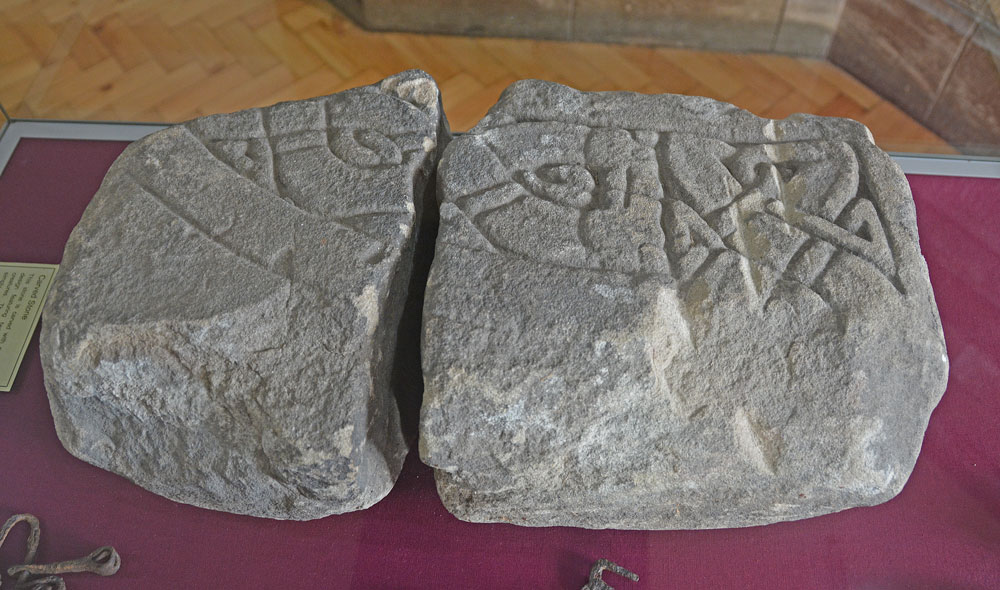
Bamburgh Castle submitted by Anne T on 10th Oct 2018. This piece of carved stone is recorded in the Corpus of Anglo Saxon Stone Sculpture as the 'Bamburgh Castle' stone. Its style dates it to the last quarter of the eighth century to the first quarter of the ninth. Originally described in the 19th century as part of a large cross head, it is know known to be part of the arm of a stone chair or throne. A reproduction can be found outside the keep of the castle, although the Corpus says it is not clear if it is meant to be part of the back or seat.
(View photo, vote or add a comment)
Log Text: Wells and Anglo Saxon Stones at Bamburgh Castle: Note: there is disabled parking next to the State Rooms, but there are many stairs in and around the castle. It’s been a long time since we last came here, and the visit today happened because I’d been sent a 1947 Antiquarian paper about the holy wells of Northumberland. There was also one piece of AS stone in the archaeological museum; listed on the Corpus, which we had still to see.
It was sunny but windy, high up above the sea. It was expensive to get in, but actually was worth the money, as we spent hours here, both wandering around inside and outside.
We found another stone with Celtic Heads in the small Stones Museum, along with a 9th century mortar stone which had been reused to hold a post.
The carved Anglo Saxon stone was in the new Archaeological Museum and Activity area, and there is a recreation of the chair/throne the chair may have looked like outside the keep. This was a favourite for photographs for visitors, so we looked at when it got quieter at the end of the castle opening hours.
Before our visit, I had contacted the castle to try and ascertain the location of three wells inside the castle. There is one well in bottom of keep; the other on the outside wall of the castle at its north western end (no longer visible, but the site can be seen, although covered in sand). The third well we thought we’d found, as we walked up the old Victorian footpath to the castle from the beach, but we were mistaken as we’d had the 1860 OS map orientated wrongly!
Once we’d been round the castle near the ticket office (found when walking back to the car park from the old Victorian footpath from the beach to the castle).
St Aidan's Church (Bamburgh)
Trip No.102 Entry No.2 Date Added: 12th Oct 2018
Site Type: Early Christian Sculptured Stone
Country: England (Northumberland)
Visited: Yes on 9th Oct 2018. My rating: Condition 3 Ambience 4 Access 5
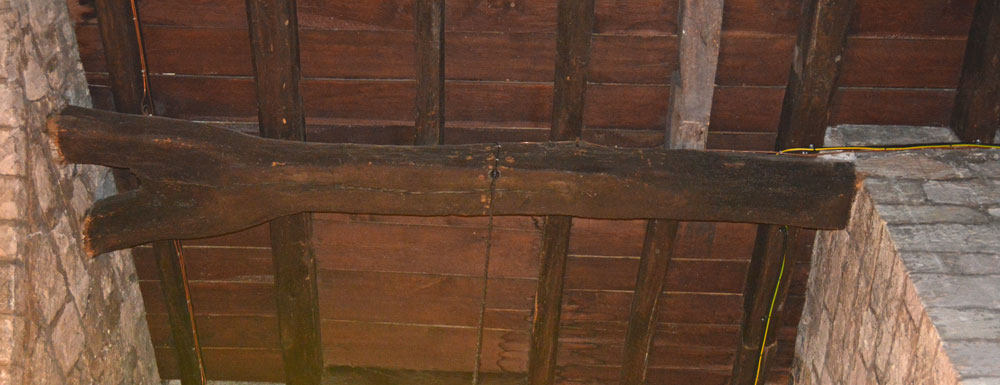
St Aidan's Church (Bamburgh) submitted by Anne T on 12th Oct 2018. "All that remains (of the original wooden church on this site) is a forked beam which can now be seen in the ceiling above the font. Bede’s account of Aidan’s death describes him as leaning against a beam when he died, in a shelter built for him outside the church. With the beam surviving at least two fires it became an object of veneration and was through to have miraculous healing qualities. People came to touch it and even take bits away. Years later it was built into the baptistry to k...
(View photo, vote or add a comment)
Log Text: St Aidan's Church, Bamburgh: We hadn’t intended to visit this church, but having seen two wells located in the property immediately to its east, we decided to take a look before heading off to the castle. The church is open during daylight hours, and is very welcoming, with lights in the nave, chancel and sanctuary, and a great display of literature and guide books.
With this church being so old (there was a cell of St Aidan and a monastery on the site), I was surprised there was no remnant of a preaching cross or cross base. To ensure I didn’t miss anything, I picked up the laminated church guide and ran through the features. It mentioned a timber from the original church, placed in the ceiling above the font. The church was so dark at this point (right at the west end of the church) that I sought lights to illuminate the spot, and looking up, indeed there was a very large (cruck) timber.
The guide also mentioned two old tombstones in the churchyard which are said to be older than the present church. I found one, but not the other.
Grace Darling also has a memorial in the churchyard.
Walking down the eastern wall of the churchyard and looking over to the farm buildings beyond, we identified the sites of two wells marked on the 1860 OS map.
St Aidan's Well (Bamburgh)
Trip No.102 Entry No.3 Date Added: 12th Oct 2018
Site Type: Holy Well or Sacred Spring
Country: England (Northumberland)
Visited: Yes on 9th Oct 2018. My rating: Condition 3 Ambience 3 Access 5
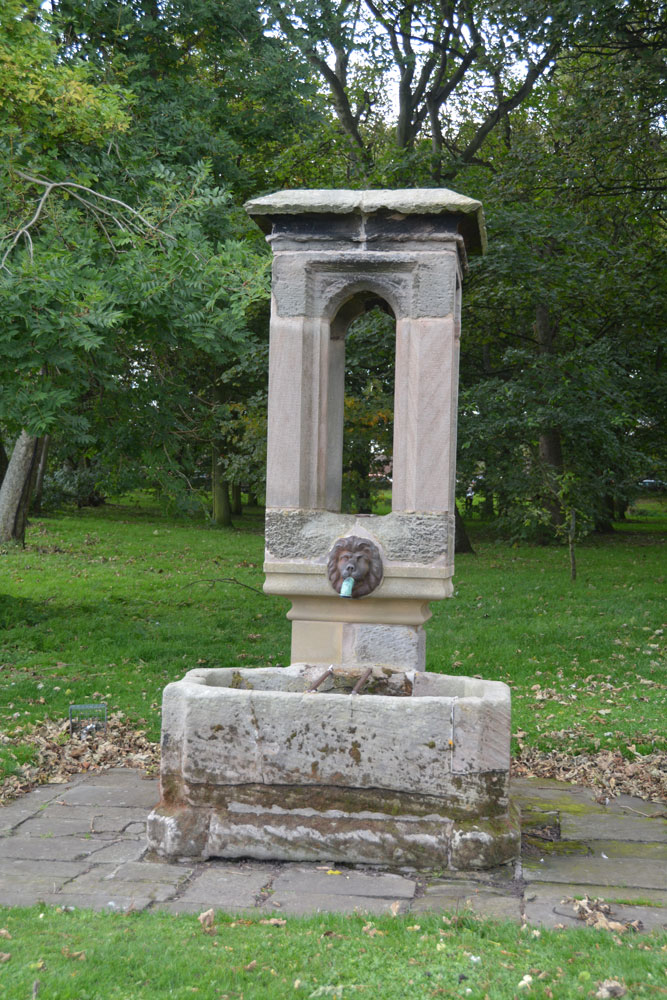
St Aidan's Well (Bamburgh) submitted by Anne T on 12th Oct 2018. First view of St Aidan's Well, standing just east of it, looking west across the triangular village green.
(View photo, vote or add a comment)
Log Text: St Aidan's Well, Bamburgh: This well seemed to form a ‘hub’ for visitors, with a school party and tourists sitting on the benches and grass around this structure, so we needed to make two trips to this well. By 5.30pm there was no one around (apart from the blue wheelie bins lined up along the street!). Obviously a modern structure, but this appears to be the original holy well associated with the church.
The well is now dry, which is a shame, as I'd have loved to see the water gushing into the basin. It might be a modern well housing, but this may well be an ancient site.
In 1947, when Revd Binnall and Miss Dodds produced their list and descriptions of Holy Wells in Northumberland and Durham, the village green was a small plantation of trees. Pastscape notes the name 'St Aidan's Well' is not known locally, but I don't know what it is called. The antiquarian notes mention it was mentioned as 'Edvn. Well' although I'm not sure was Edvn means.
Bamburgh Barrow 1
Trip No.102 Entry No.6 Date Added: 13th Oct 2018
Site Type: Round Barrow(s)
Country: England (Northumberland)
Visited: Saw from a distance on 9th Oct 2018. My rating: Condition 1 Ambience 3
Bamburgh Barrow 1 submitted by SolarMegalith on 13th Feb 2014. A Bronze Age cist with broken capstone and one of the upright stones visible (photo taken on February 2014).
(View photo, vote or add a comment)
Log Text: Rubbing Stone & Tumulus, Bamburgh: Spotted this apparent 'standing stone' in the field when we were walking back along Doctor's Lane towards St Aidan's Well. There was no obvious way into the field along this route, and we'd already walked for miles, so we contented ourselves with photographing from the stone wall in the next field.
On researching this site when I got home, found out that it was marked on the 1860 OS map as a tumulus with rubbing stone. The tumulus has now been destroyed and the stone is a 19th century insertion into the mound.
Had we realised there was still a visible cist, we might have tried harder to access the field. However, there is such a lot of history in Bamburgh, I'm sure we'll be making a return trip in the not too distant future.
St Oswald in Lee (Heavenfield)
Trip No.103 Entry No.1 Date Added: 13th Oct 2018
Site Type: Ancient Cross
Country: England (Northumberland)
Visited: Yes on 11th Oct 2018. My rating: Condition 3 Ambience 4 Access 4
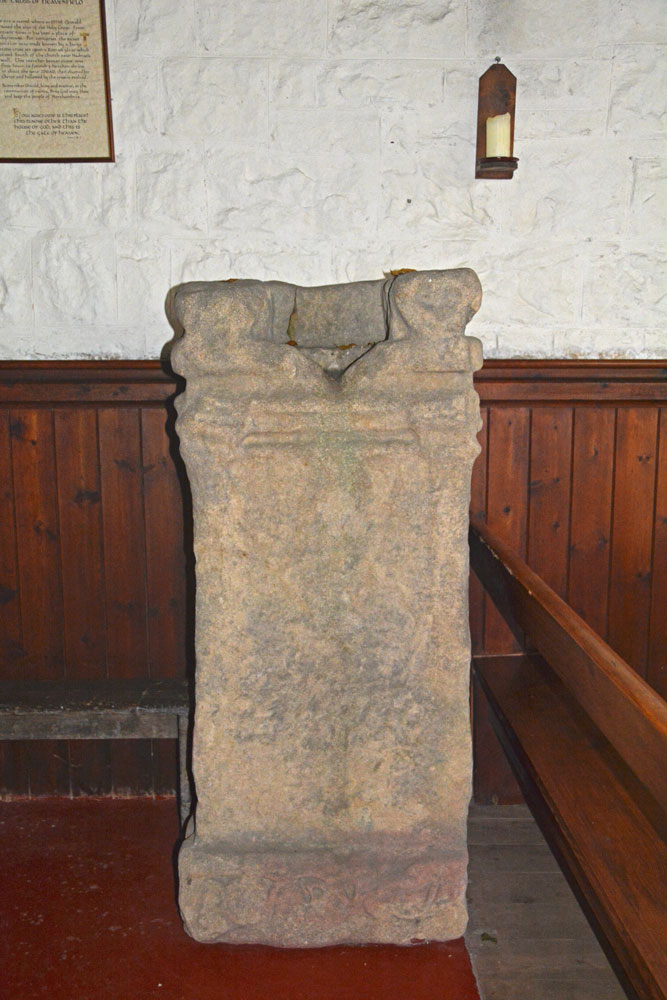
St Oswald in Lee (Heavenfield) submitted by Anne T on 13th Oct 2018. The southern side of the repurposed Roman altar, which is opposite you as you enter from the south door. Recorded as AS Corpus 02, this side has lettering and ornamentation, most of which has been obliterated, but at the base there is a vine trail.
(View photo, vote or add a comment)
Log Text: Heavenfield cross shaft and cross base: We have been to this church before, but didn’t realise the Roman altar had been recut for reuse as a cross base, so decided to revisit it. It is in a really glorious location. The church is set back from the road, so we parked in the layby by the large wooden cross and went through the gate into the field full of enormous sheep. You have to cross the vallum for Hadrian’s Wall to walk to the church, although this is now largely ploughed away.
Inside the porch, on the western shelf/bench, are the two pieces of AS Corpus St Oswald in Lee 01. As you go in through the south door, AS Corpus St Oswald in Lee 02 is straight in front of you. An information ‘board’ is on the wall next to the cross, which reads: “The cross of Heavenfield. The site is sacred where in 635AD Oswald raised the sign of the Holy Cross. From ancient times it has been a place of pilgrimage. For centuries the exact position was made known by a large stone cross set upon a Roman altar which stood south of the church near Hadrian’s Wall. This weather beaten stone was first hewn to furnish a heathen shrine in about the year 200AD, then claimed for Christ and hallowed by the cross it exalted. / Remember Oswald, king and martyr, in the communion of saints. Pray God may bless and keep the people of Northumbria. / How awesome is this place! This is none other than the house of God, and this is the Gate of Heaven. Genesis, 28.17”
On the south wall of the nave is what the church guide refers to as a mason’s mark, but it is very large to be one. It looks like an upside down Templar cross.
Also on the north wall of the nave is a small fragment bearing chevrons and small balls – this is dated to the Norman period.
The churchyard wall is also built with Roman stones.
St Andrew's Church (Bolam)
Trip No.103 Entry No.2 Date Added: 13th Oct 2018
Site Type: Ancient Cross
Country: England (Northumberland)
Visited: Yes on 11th Oct 2018. My rating: Condition 3 Ambience 4 Access 5

St Andrew's Church (Bolam) submitted by Anne T on 13th Oct 2018. This is AS Corpus Bolam 01, an eleventh century round-headed grave marker measuring 78.8cms high, 40cms wide and 13cms deep. It is propped against the south wall of the tower, inside. The horizontal arms of the cross touch the edges of the stone. Found in 1884 when the church was refurbished.
(View photo, vote or add a comment)
Log Text: St. Andrew's Church, Bolam: Hogback, Ancient Crosses and Sculptured Stones: It is almost four years to the day when I first visited this church (15th October 2014), but had only just started making contributions to the Portal and thought the cut-off date for any entries was 1,000AD. That visit took place on a beautiful sunny day with no wind; the church was peaceful and tranquil, and I sat and read the guide book, enjoying the atmosphere of ages. Today, the wind rattled the door with great frequency, and the wind whistled through the crack, making it sound like there was a cat howling outside. I was glad of company today!
As well as the AS fragments in the church, a hogback and other grave markers built into the porch, there is also the remains of a cross and cross base.
This is the church where a German bomb came through the south wall but did not explore. The pilot later visited the church to apologise and arranged for a window to be inserted into the east wall of the south aisle – an angel holding a candle.
The information sheet ‘Earth’ says “the oldest part of the church is the Saxon tower, and you can find traces of a sundial inside the porch.” We spent ages looking for this, but couldn’t find it.
The saltire marked stones on either side of the chancel arch were fascinating, as was the arch between the nave and the chancel.
Above the south door, in the porch, are the remains of two triangular inscribed grave slabs (mentioned in the architectural assessment).
St Cuthbert's Church (Bedlington)
Trip No.103 Entry No.3 Date Added: 13th Oct 2018
Site Type: Sculptured Stone
Country: England (Northumberland)
Visited: Yes on 11th Oct 2018. My rating: Condition 3 Ambience 4 Access 4

St Cuthbert's Church (Bedlington) submitted by Anne T on 13th Oct 2018. This carved stone, AS Corpus Bedlington 01, has now been built into the west wall of the nave, inside. The lighting is not brilliant, as it is sited immediately underneath the floor of the organ loft, and even with a flash, this was almost beyond my photographic skills. Dated to the tenth century, this worn slab has two figures, both with halos, the right hand figure holding a rod and with its right hand raised in blessing.
(View photo, vote or add a comment)
Log Text: St Cuthbert's Church, Bedlington: The Corpus told us the stone we were looking for was on the external east face of the nave. We were joined by a group of four boys who wandered into the churchyard and wondered what we were doing, so I told them, showed them the image, but none of us could find it. Looking through the architectural assessment I found it had been moved into the church and were on the west wall of the nave.
There were lights on in the church but the doors were locked. On our second try, the door opened and the Brownie Leader popped her head out. She very kindly let us into the church for a look around.
The south wall of the church is very old, but the rest of the exterior is Victorian. The nave of the church inside is incredible. Most of the grave markers were hidden behind the spiral staircase leading up to the organ, but I tried my best to photograph them.
Leper's Well (Bamburgh)
Trip No.102 Entry No.5 Date Added: 13th Oct 2018
Site Type: Holy Well or Sacred Spring
Country: England (Northumberland)
Visited: Yes on 9th Oct 2018. My rating: Condition -1 Ambience 3 Access 4

Leper's Well (Bamburgh) submitted by Anne T on 12th Oct 2018. We tracked down the grid reference/location of the leper's well from the 1860 OS map, but there is nothing here now apart from a modern manhole cover. Does anyone else know anything about this well? In 1955, Pastscape record an entry that says "the well here is modern". I wondered when it disappeared.
(View photo, vote or add a comment)
Log Text: Leper's Well, Bamburgh: Guided by the grid reference given on Pastscape, we walked down Doctor's Lane from St Aidan's Well. Some of the old stone walls around properties, and at the sides of the lanes running off here are ancient, and we thought they could well belong to the old leper hospital.
The grid reference took us to the corner of a row of cottages, where there was a modern manhole cover. The well was last recorded in 1955, so it looks as if it has now been destroyed. I took a few photos of the site, just in case.
Andrew called up the 1860 OS map on his phone and we were confident we had the right location. When I got home, I used the Pastscape and HE entries which gave distances (the dovecot is 140 NE of leper hospital) to triangulate the location of the well, and it agrees with the spot on the old OS map and the spot I photographed.
Bedlington Market Cross
Trip No.103 Entry No.4 Date Added: 13th Oct 2018
Site Type: Ancient Cross
Country: England (Northumberland)
Visited: Yes on 11th Oct 2018. My rating: Condition 3 Ambience 3 Access 5

Bedlington Market Cross submitted by Anne T on 13th Oct 2018. The Bedlington Market Cross (or obelisk), which is very different from the style of other market crosses in Northumberland and the Scottish Borders that I've seen (so far). The top obelisk looks much more modern than the pedestal, although the two are apparently of the same age.
(View photo, vote or add a comment)
Log Text: The Market Cross, Bedlington: We spotted this rather unusual market cross on our way to St Cuthbert's Church to see the tenth century carved slab, now inside the church. The road was less busy on our return, and we managed to pull into the small car park outside the hairdressers opposite (it was shut for the night) and I walked across the road to take some photographs.
I have to confess this is a pretty ugly structure, and well done to whoever uses it as a private parking spot. I was surprised to find this was a Grade II listed structure, built apparently in 1792.
The surrounding flower beds and town signs all proclaimed "The Bedlington Terrier", so presumably this is where those dogs originated.
St Cuthbert's Well (Mitford)
Trip No.104 Entry No.2 Date Added: 24th Oct 2018
Site Type: Holy Well or Sacred Spring
Country: England (Northumberland)
Visited: Yes on 24th Oct 2018. My rating: Condition 3 Ambience 3 Access 5
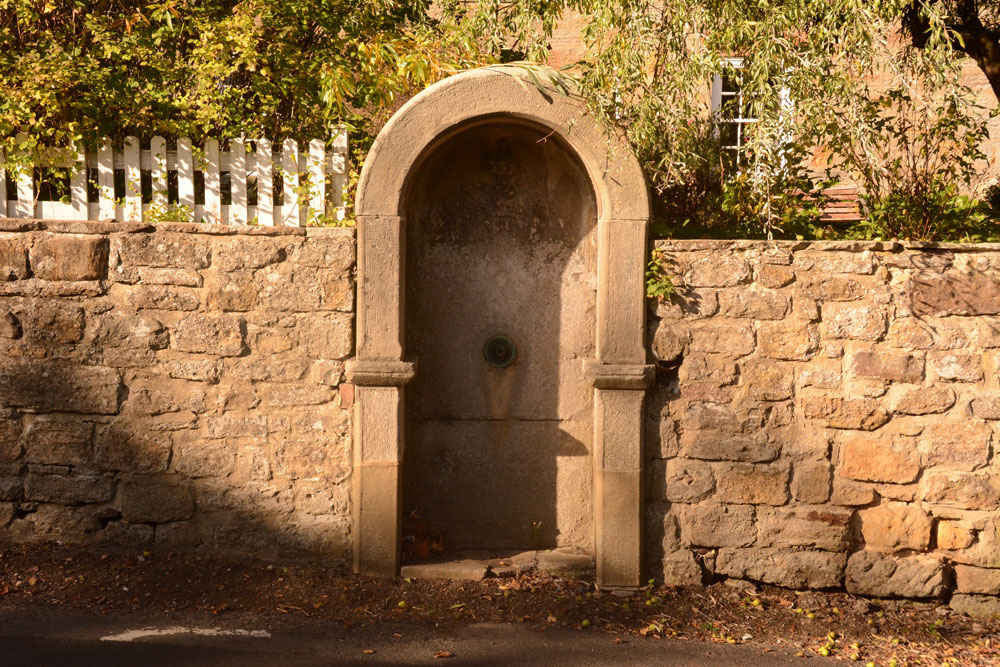
St Cuthbert's Well (Mitford) submitted by Anne T on 24th Oct 2018. The well/fountain housing is built into the wall of the Old Post Office, at the side of the B6343.
(View photo, vote or add a comment)
Log Text: Site of St Cuthbert's Holy Well, Mitford: After having visited Bothal church and spent well over an hour looking around, we stopped off at The Old Chantry tea rooms in Morpeth for a bowl of soup and a cup of tea, then headed off to the small, but very pretty village of Mitford, just over 2.5 km west of Morpeth.
OK, so there is no longer a well here, and the Victorian-era drinking fountain structure that was built in the place where the well was supposed to have been is now dry, it was easy to find. The road is reasonably busy, so I risked getting run over to get a few close up shots. The carving of the impaled dragon's head (I didn't realise what it was until I saw the photos on the larger screen of the computer and read the Historic England description) was pretty gruesome.
We did wander down to the river and walked along a little way. Someone has built what appears to be a very pretty, but very modern, thatched cottage by the side of the footpath along the river.
Note for next time: the pub does special offers on food for pensioners!
Jemmy's Well (Cambo)
Trip No.104 Entry No.3 Date Added: 25th Oct 2018
Site Type: Holy Well or Sacred Spring
Country: England (Northumberland)
Visited: Yes on 24th Oct 2018. My rating: Condition 3 Ambience 3 Access 4
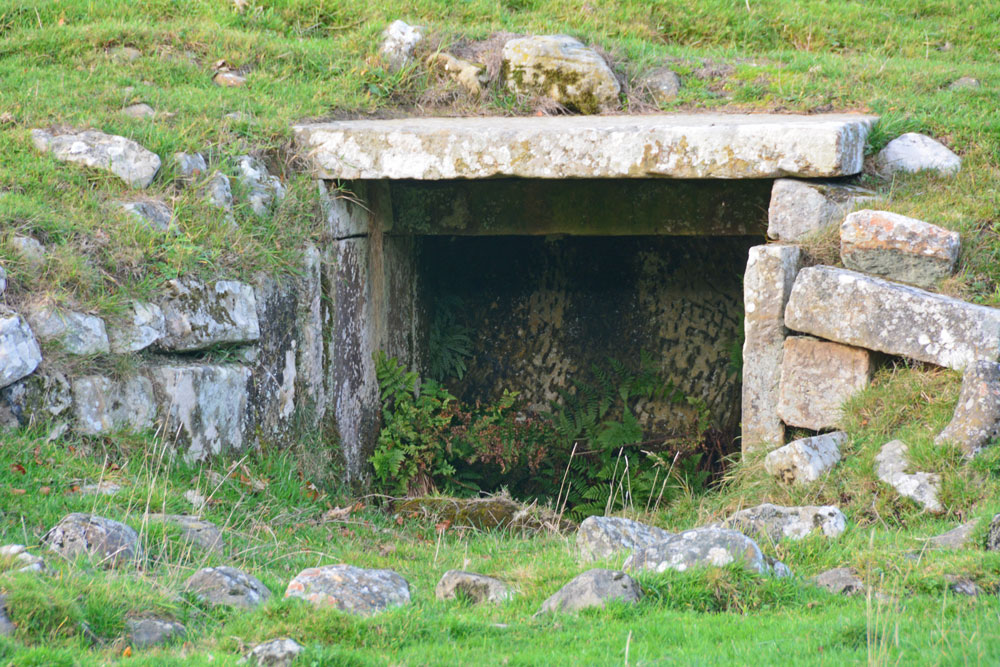
Jemmy's Well (Cambo) submitted by Anne T on 25th Oct 2018. Using the camera lens almost on maximum zoom to try and see the inside of the well house. I will try and get permission to walk across the field and take a closer look in the relatively near future. The half circle of stones outside the well house indicates there used to be a pool at some time in the fairly recent past.
(View photo, vote or add a comment)
Log Text: Jemmy's Well, Cambo: One of three wells in the village of Cambo, but only this one is marked on the modern OS map, and the only mention we found of it was in Binnall and Dodd's 1941 'Holy Wells of Northumberland and Durham' document. The well lies on private land, just south of Cambo School, and the well field had at least half a dozen horses in it; to avoid upsetting the horses, we let ourselves into the field to the south, using the gate near the wood alongside the B6342, then walking north to where a 'bridge/track' has been created over the small stream to the south of the well field.
I found the 1863 OS maps when I got home, and the other two wells are marked, to the south west of Jemmy's Well; where these are the two mentioned by Binnall and Dodds (Hepple's Well and Stinky), I'm not sure, but the are close enough to supply the village.
I'd like to get permission to get into the well field and take a closer look. Whilst the well looked dry at the time of our visit, the semi-circle of stones outside the well house indicated there had been a well pool there at some time in the fairly recent past.
Lady Well (Bavington)
Trip No.104 Entry No.4 Date Added: 25th Oct 2018
Site Type: Holy Well or Sacred Spring
Country: England (Northumberland)
Visited: Yes on 24th Oct 2018. My rating: Condition 2 Ambience 4 Access 4
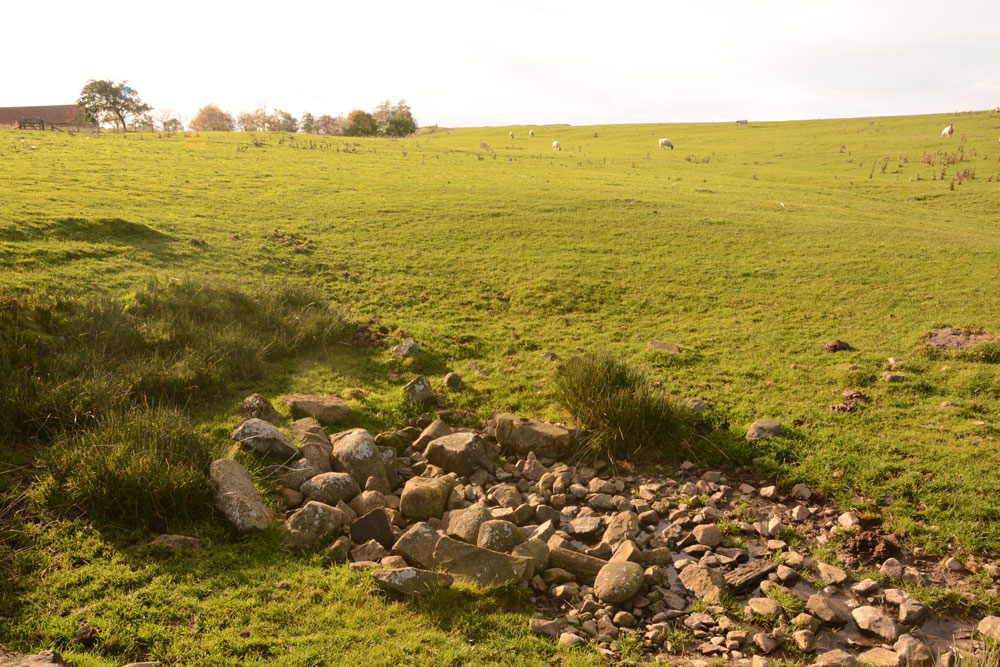
Lady Well (Bavington) submitted by Anne T on 25th Oct 2018. The well from the north east. From the relatively large number of dressed stones at and around the well head, it looks as if there was a well house or structure here at some time. This is the source of the Kirkharle Burn.
(View photo, vote or add a comment)
Log Text: Lady Well, Bavington: This is a lovely spot, and well worth the short walk to and from the road to see this well (or what remains of it).
We parked at NY 99286 80701, just off the B6342, and followed the track northwards towards Ladywell Farm. There was a big boulder with lots of cut marks at it at the top of the track, and I worked out it said ‘Ladywell’ on it, although the marks looked more like runes than letters!
There are no records on Pastscape or HE, although the well is marked on the OS map. Ladywell Farmhouse is recorded as Historic England List ID 1044928, although this is largely 17th and 18th century.
The footpath goes right past the right hand side of the farm, then deviates off slightly north east, through a kissing ate. Walking straight ahead, there was a dip in the ground with some marsh grass around it to our right, so we made a beeline for this. There was a heap of pebbles in the dip, with a stream of water emerging from the ground between the stones – no great rush of water, just a gentle flow. Judging by the dressed stones at the southern end of the pile of pebbles, it looks as through there might have been a well house or pool surround at some point.
Oh the wind, which must have been a steady 30mph plus on our walk there and back! My ears and cheeks burned when I got back into the car after this walk, although it was nice to actually walk to a site and back, even though it was a relatively short distance.
St Andrew's Church (Bothal)
Trip No.104 Entry No.1 Date Added: 25th Oct 2018
Site Type: Ancient Cross
Country: England (Northumberland)
Visited: Yes on 24th Oct 2018. My rating: Condition 3 Ambience 4 Access 5
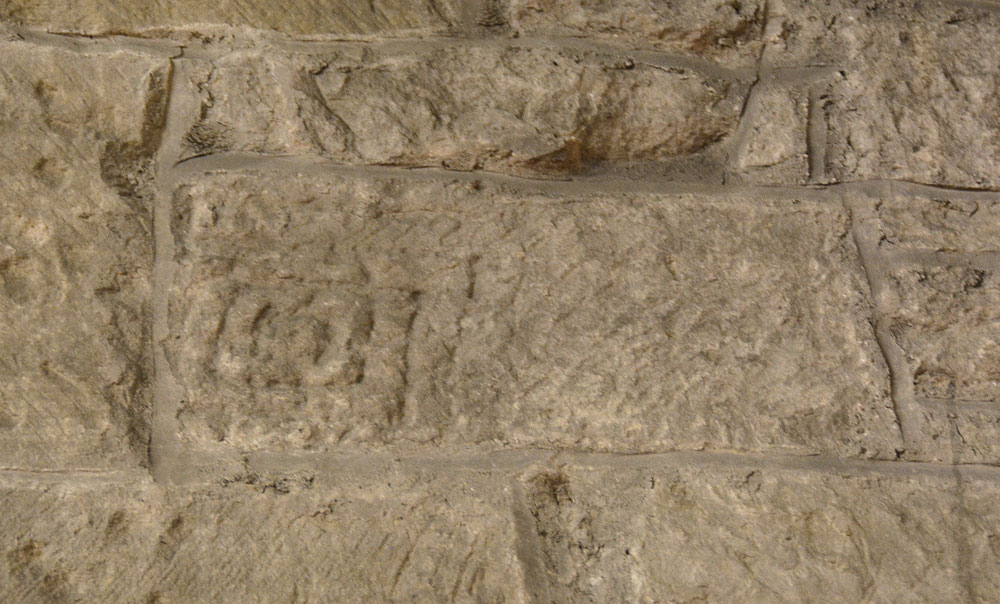
St Andrew's Church (Bothal) submitted by Anne T on 25th Oct 2018. This is AS Corpus Bothal 07, part of a cross shaft built into the north wall of the chancel (towards its western end). Dated to the late tenth to early eleventh century, we initially had difficulty in picking this stone out, but once we'd seen it, could not 'unsee' it. The Corpus describes the pattern as 'formed by concentric punch outlined rectangles with a coiled centre.'
(View photo, vote or add a comment)
Log Text: Anglo Saxon Cross Shaft Fragment, St Andrew's Church, Bothal: I had arranged to collect the key to the church from the Reverend John Parks, who lives in Pegswood. The church in Bothal is very easy to find, and in a very scenic place, with a nearby footpath running down to the River Wansbeck.
The narrow west end of the church faces the road, and is largely hidden by tall, dense trees. My first thought was “how am I going to photograph the outside?” This did prove to be a little bit of a challenge, but in the end, walking into the much larger and spacious churchyard, I managed a couple of shots.
There are a number of entries on HE for St. Andrew’s Church, and whilst we spent about an hour and a half here, I felt I wanted to stay longer to explore all the elements in the guide book and the architectural assessments, but Andrew was getting bored and a cup of tea in Morpeth then holy wells beckoned.
There are several really interesting ‘cut outs’ of the wooden panel in the chancel that give viewing access to a remnant of medieval plasterwork, an old tombstone reused as a lintel, and an old wooden door. The cut outs were quite small, which made photographing these features a little tricky. At one point, I thought I was going to drop the camera down the small window on the south wall of the chancel, in an attempt to photograph the bottom of the lintel above! Photographing the remnant of medieval plasterwork was interesting, as Andrew had to shine the torch (kindly provided by the church in a neat holder next to the grille) whilst I manually focussed the camera. Not a great photo by any means, but I had fun trying!
On the eastern and northern external walls of the church there are musket ball holes.
Limestone Brae (West Allen)
Trip No.112 Entry No.1 Date Added: 13th Dec 2018
Site Type: Ancient Cross
Country: England (Northumberland)
Visited: Yes on 9th Dec 2018. My rating: Condition 3 Ambience 4 Access 4
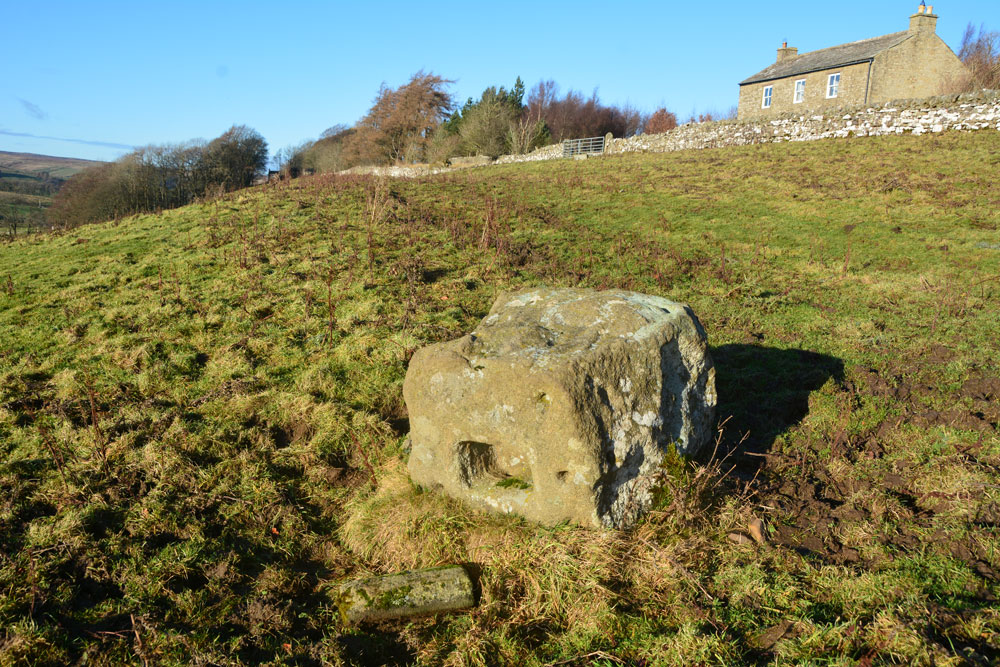
Limestone Brae (West Allen) submitted by Anne T on 13th Dec 2018. Standing just south west of the cross base, looking back towards the road and Glengarrif House. As it's such a large stone, we wondered how it became overturned, and when.
(View photo, vote or add a comment)
Log Text: Limestone Brae Overturned Cross Base: We parked next to the chapel, just before the lane to Throssel Hole Buddhist Abbey. At first sight this stone just seemed like a boulder in the field. “Are you sure that’s it?” I asked my husband. We let ourselves in through the gate into the field and walked along the tussocky grass to the stone. As soon as we saw the other side, it was obvious this is an old cross base which has been overturned.
Looking to the gate to the south of the cross base, there looks as if there is an old hollow way, somewhat obscured by its use as a quad bike route, but there is a definite dip in the ground. The cross has superb views west/north west over the River West Allen Valley.
Park House (West Allen)
Trip No.112 Entry No.2 Date Added: 13th Dec 2018
Site Type: Marker Stone
Country: England (Northumberland)
Visited: Yes on 9th Dec 2018. My rating: Condition 3 Ambience 4 Access 4
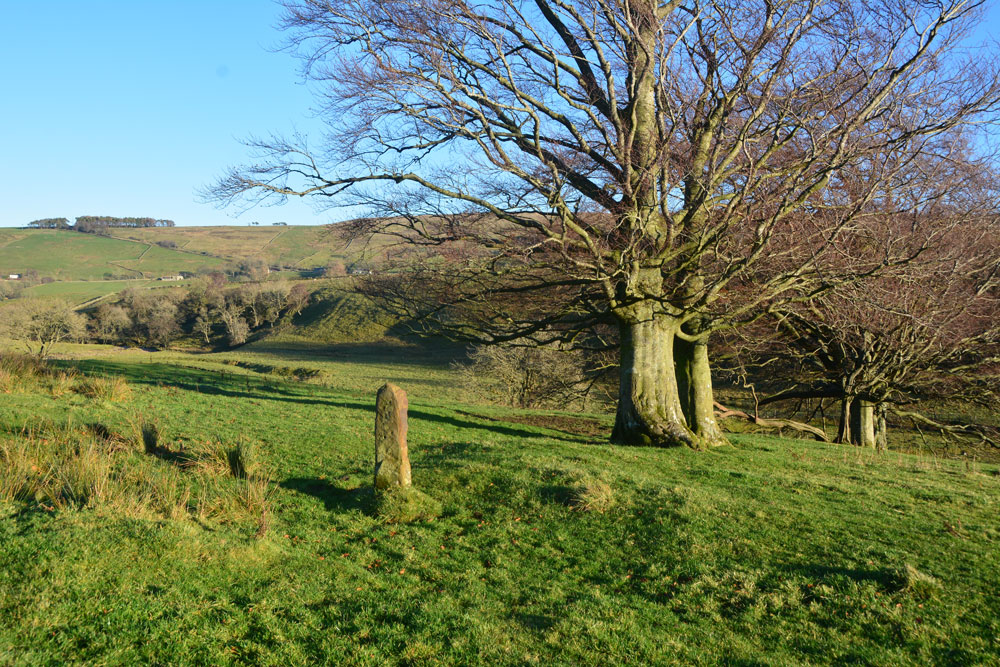
Park House (West Allen) submitted by Anne T on 13th Dec 2018. First view of this boundary marker/standing stone/gatepost, walking north along Isaac's Tea trail from Park House, with the Mohope Burn running more or less along the centre of the photo.
(View photo, vote or add a comment)
Log Text: Boundary stone (?) near Parkhouse, Mohope Burn, West Allen: Andrew found this stone in a book about Isaac’s Tea Trail in Waterstones in Hexham, and as this is an area we’ve not really explored before, we decided to drive out and take a look. Andrew says no one is sure what this stone is – an old standing stone or a boundary marker, or something else.
We walked down the lane eastwards towards Park House, where a sign post directs you to ‘Malakoff Bridge 1”. The path goes through the garden of the house and along its north-south eastern boundary with the Mo Hope to your right hand side. A kissing gate leads onto Isaac’s Tea Trail, running north south. The stone is approximately 2/3rds of the way into the second field. We needed wellies at there was a considerable amount of standing water near the field gates.
This valley is really beautiful. Such a remote valley, but with lots of houses scattered about. The Mohope Burn meanders to your right (eastern side). The stone sits in a row of trees, and my immediate thought was that it was a gatepost, but it doesn’t line up with the other gaps in the stone walls.
There is nothing recorded on Historic England or Pastscape for this location, although the HE map shows the stone lies between the Mohope Burn (to its eastern side) and Blind Burn (to the west). A quick search on Pastscape reveals the whole area has lead mines within 1km of this stone plus lime kilns. Pastscape 957727 records a lime kiln nearby the stone at NY 7750 5106, some 30m to the north.
Going to the next field boundary, a track carries on north-south, but another drops down to the Mohope Burn. Perhaps the stone marks the edge of a trackway and a possible ford across the river?
Tommy Stout's Well (Thornley Gate)
Trip No.113 Entry No.1 Date Added: 1st Jan 2019
Site Type: Holy Well or Sacred Spring
Country: England (Northumberland)
Visited: Yes on 1st Jan 2019. My rating: Condition 3 Ambience 4 Access 4
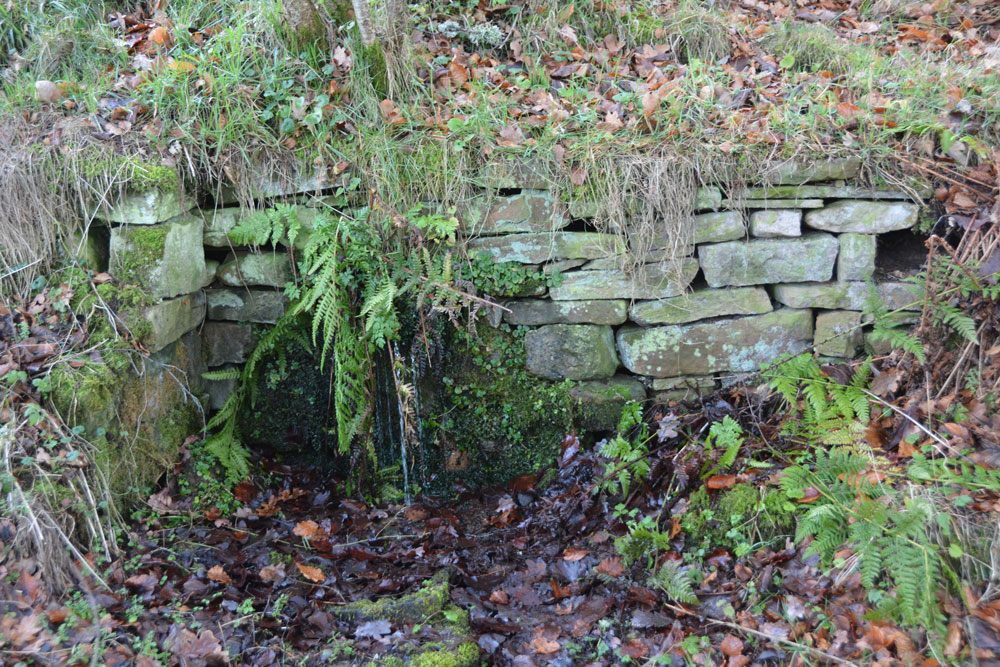
Tommy Stout's Well (Thornley Gate) submitted by Anne T on 1st Jan 2019. At first the well looks just like part of a small retaining wall by the side of the path running above the southern side of the River East Allen. As you get closer, you can see (and hear) a steady stream of water issuing from underneath a slightly protruding dressed stone in the middle of the wall. Now covered by ferns and lichen, it wasn't possible to determine whether the water came through a pipe, even running my fingers gently under the water to check - too much shrubbery. The water was cle...
(View photo, vote or add a comment)
Log Text: Tommy Stout's Well, Thornley Gate: Another site ticked off the list of Isaac’sTea Trail. This is obviously a popular spot for walkers, as there are paths both sides of the river, and we passed a number of dog walkers. The small layby on the south side of the river was full (2 cars), so we parked on the grass verge by the entrance to the Allen Smelt Mill.
The well is through the kissing gate on the opposite side of the road from the smelt mill gate, with the well some 15m further on, to your left hand side.
Water appears out of the hillside below a small protruding dressed stone, largely hidden by moss and lichen. There is a fair flow of clear water which comes out; I did taste it, but there was nothing really to taste. Above the simple, dressed stone well head with drain there is a marshy area in the field above, from which the source of the water appears to come. Between the well and the kissing gate, on the other side of the fence, is a stunning little stream with a mini waterfall, which is a different water course to that of the well.
Also being interested in some industrial archaeology, we spent some time wandering around the fascinating remains of the smelting works opposite. There is still quite a lot left, and it is left accessible for visitors. Some of the underground flues are currently being excavated.
